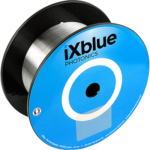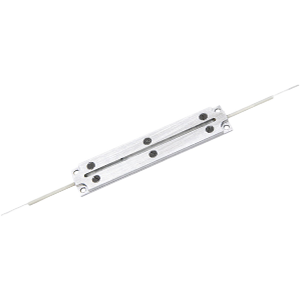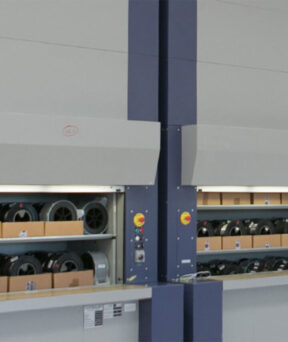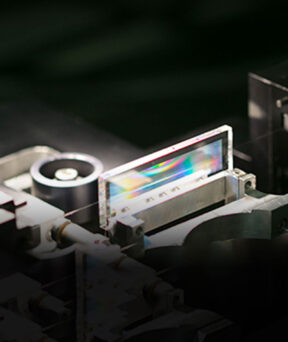- Photonics & Space
Fiber lasers in the 2 µm range


Today, new applications are rising for 2 µm fiber lasers, which has driven recent innovation in specialty fiber technology. Even if still more expensive than the 1 or 1,5 µm lasers, the 2 µm lasers address “niche” markets but with strong added value. If one of the main advantages of the 2 μm laser is its power, it also has a considerable asset for many applications as it is “eye-safe”, meaning that our eye is sensitive to its beam and instinctively closes itself when touched.
iXblue has 20 years of experience in the manufacturing of doped fibers. iXblue portfolio offers a range of Thulium & Holmium doped optical fibers for amplifiers and fiber lasers, but also high-performance modulation solutions (LiNbO3 modulators and ModBox) and integrated micro-optics benches adapted to this new wavelength range.
Why are 2 µm fiber lasers a new trending technology?
When the 1 µm fiber lasers doped with Ytterbium (Yb) have the highest efficiency (70-80%) and can reach up to 1-3 kW from a laser cavity, they are dangerous to handle as they are not “eye safe”. They can reach deep inside any operator eyes and damage it irreversibly, even after a reflection on a reflective surface. Regarding the 1.5 µm fiber lasers doped with Erbium (Er) and Er/Yb, for which iXblue has become a world expert manufacturer, they have a limited efficiency (30-40%) when only doped with Er and increase of efficiency is only average when co-doped by Er/Yb. Its main advantage comes from its inheritage from the telecom industry, and it is widely used today for LIDAR applications only.
The 2 µm fiber lasers doped with Thulium (Tm) and Holmium (Ho) seems to be the next step to follow, for being “eye-safe” and for having a greater efficiency than 1,5 µm fiber lasers. If challenges remain for its large adoption, including the lack of available components and their price, and limitation of the max power achievable for CW operation due to high heating, the potential remains important for certain applications:
- where eye-safety is critical, in open area with potential reflective surface (ex: counter defense applications)
- for atmospheric gas monitoring, due to the increased measurement range and the finer measurement possible
- for medical laser, due to the favorable absorption in water that drastically reduces the penetration depth of the 2 µm wavelength in tissue (ex: treatment in urology)
- for plastic welding, as 2 µm fiber laser has enough thermal heat to process clear/transparent plastic without additive bonding.
What is the current scope of applications for 2 µm fiber lasers
Fiber laser manufacturers are the one mainly interested by this new 2 µm range because of the advantages described before, with dozens of key players involved, but academics and R&D/service based company also represent a large market. In term of applications, two main ones can be identified:
- The 2 μm laser for LIDAR with applications in defense and environment
The generic term of LIDAR for LIght Detection And Ranging finds its use nowadays in many different systems and applications, from the scanning of surroundings to create a 3D digital map of obstacles (for instance in autonomous driving applications) to atmospheric Lidars that detect gases or aerosol particles (for instance in environmental applications). Another well spread application is the detection of atmospheric turbulences to secure wind-turbines operation or airports. All these systems have different requirements in terms of wavelength, power and pulse profiles.
iXblue offers a wide range of specialty fibers and Electro-Optic Modulators (EOMs) that can answer the various challenges of the applications opened today for 2 μm fiber lasers, in particular in defense. The French-German Research Saint-Louis Institute (ISL), at the occasion of a research program with the DGA (French Government Defence procurement and technology agency), has obtained and presented in 2021 some interesting results using an iXblue optic fiber: a monolithic laser source with Tm-Ho co-doped fiber in single oscillator emitting 195 W at 2090 nm in continuous mode (A. Motard and al. Optics Express (2021)). It makes 2 µm fiber lasers ideal for applications in optical systems that can deliver very high power for defense applications. Being “eye-safe” means that they are perfectly suited to operational environments, for example embarked on ships or moving vehicles.
200W Laser cavity with iXblue Thulium double clad Fiber (courtesy of French-German Institut of Saint Louis – ISL)
- The 2 μm laser for urology
An interest is rising among medical laser manufacturers for Tm-doped fiber. Laser technologies are used in flexible ureteroscopy, for ureteric and kidney stone management. The goal is to be minimally invasive without breaking the skin barrier. The thulium fiber laser has several advantages over the Holmium YAG laser, traditionally used in urology. With a wavelength of 1940 nm, the absorption coefficient of Tm fiber laser is four times greater in water (1940 nm matches the near-infrared absorption peak of liquid water at room temperature), and it enables much smaller spot sizes to be created with less powerful pulses but at a much higher rate. It has average and peak powers of 100 W and it does not burst tissues, providing clean and precise cutting. It allows for pulse prolongation up to 12 ms, with regular pulses. Therefore, the power produced by the laser has a constant peak, called the super pulse creation. It is perfect for surgical applications, providing even greater precision and less collateral damage.
iXblue has developed a fiber laser cavity (a Tm doped fiber and fiber Bragg gratings – FBG), for this innovative laser technology that may become an important milestone for kidney stone treatment.

Our specialty fibers and components are produced in environmentally controlled production areas to ensure high proof strength, tight tolerances and a highquality level. Exail’s specialty fibers facility is located in Lannion, France. It has over 25 years of experience in designing and manufacturing high performance products, with recently upgraded new facilities and expanded technical team.
iXblue portfolio for 2 µm fiber lasers
With its extensive experience and its large portfolio of doped fibers, FBG Laser mirrors, LiNbO3 modulators and fully integrated modulation solutions (ModBox), iXblue can support the emergence of innovations in 2 µm fiber lasers. iXblue solutions to reach high-power (around 50 W) lasers but also power scaling in lasers will draw the attention of expert as they are based on proven-and-tested manufacturing processes.
The iXblue know-how on special optic fibers led to the development of a specific “HP” process for high-power applications, on top of the already existing expertise in term of excellent matching of (passive/active) optic fibers and in term of packaging for optimal thermal dissipation. The resistance towards heat is increased by a factor 10 with iXblue FBGs compared to the competitors’ solutions.
The doped fibers in the iXblue portfolio especially address the range of 1900 to 2090 nm (i.e 1940 nm for urology, 2036 nm for LIDAR, etc.), with different absorption wavelengths available for the FBGs that can be incorporated to any kind of fiber. Most importantly, iXblue can produce custom fibers based on core co-doped with Thulium (Tm), Holmium (Ho), or both (Tm/Ho), with on demand customization: any core size (4 to 25 µm), one-two or three claddings, any kind of coating (including innovative ones for high temperature or harsh environment) and any kind of doping level. The fiber can also contain a polarization-maintaining (PM).
Active fiber
| Doping Materials | |
| Thulium | Single Clad 4 and 5 μm core, PM and non-PM Double Clad 6 to 25 μm core, PM and non-PM |
| Thulium-Holmium | Double Clad 6 to 25 μm core, PM and non-PM Triple Clad 18μm co |
| Holmium | Single Clad 8μm core, PM and non-PM Single Clad 20 μm core, PM Triple Clad 20 μm core |
Custom versions available.
Matching passive fibers
Our passive fiber product line includes a range of polarization maintaining fibers, single and multi-modes fibers, photosensitive fibers and double clad fibers.
Benefits & Features
- Pure Silica SM fiber Core
- Photosensitive SM fiber for FBG
- PM available
- Acrylate, Silicone, Polyimide, or Carbon Coated fibers
Applications
- Fiber lasers and amplifiers
Fiber Laser Cavity Mirror
| Fiber Type | Typical available Wavelengths – High Power process |
| 4 to 25μm core Single Clad, Double Clad and Triple Clad PM and non-PM Double C |
1908 – 1940 – 1950 – 2036 – 2050 – 2090 – 2120 |
DFBs
Other components available at iXblue for 2μm applications
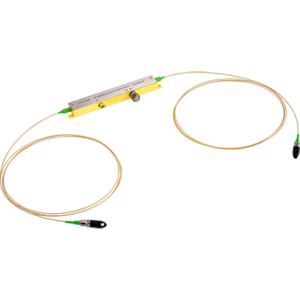
Gaining power with several combined laser beams can be done by superimposing lasers of distinct wavelengths in a uniform laser output. It can be done using the Coherent Beam Combination (CBC) technique, where the combination of several lasers by real-time control of their relative phases allows to permanently maintain constructive interferences and thus guarantee maximum power efficiency during the combination. iXblue’s Modbox CBC at 2 µm, is an optimized multi-channels phase modulation solution for multibeam coherent combination.
The ModBox integrates 2 to 8 independent channels with phase and delay tuning capability. Each channel allows an adjustment of the temporal phase for synchronization of all beams. The design integrates iXblue proprietary low frequency phase modulator with its matching RF electronic and a tunable optical delay line that is selected for high accuracy and a wide delay adjustment range. Special care is taken for the assembly of the ModBox: the iXblue electro-optical phase modulators are screened from our regular production to ensure very low insertion loss, high polarization extinction ratio, low residual amplitude modulation, and high phase modulation stability. Additionally, iXblue phase modulator is well known to be the best planar phase modulator in the NIR featuring the highest optical input power handling capability. The component selection makes the Modbox CBC at 2 µm an accurate, adjustable, and reliable phase-lock modulation solution for Coherent Beam Combining technique.
iXblue offers a new generation of fibered micro-optics benches integrating within a compact and ultra-stable package a wide variety of optical functions such as power splitters, combiners, optical switches, frequency shifters… As a result, usual free-space optics set-ups are transformed into turn-key ultra-stable integrated sub-systems. These modules feature remarkable stability and can operate at high power. For example the iXblue Variable Optical Delay Line (VODL) is a device that enables a very precise and stable control of an optical delay up to 12ns, useful to synchronize laser pulses.
